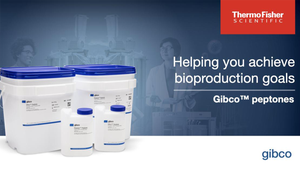- Sponsored Content
Ask the Expert: A New AEX Mixed-Mode Chromatography Resin for High Selectivity and Recovery
September 21, 2019
Sponsored by Bio-Rad
In an Ask-the-Expert webinar on 16 May 2019, Xuemei He (R&D manager of chromatography media chemistry at Bio-Rad Laboratories, Inc.) introduced the Nuvia aPrime 4A mixed-mode chromatography resin. Its macroporous particles exhibit good pressure-flow properties in addition to optimal ligand density and hydrophobicity. So this versatile resin offers effective separation of target from impurities in both flow-through and bind–elute modes, with good recovery of target proteins under gentle purification condition.
He’s Presentation
The resin is a hydrophobic anion exchanger with positively charged ligands that separate biomolecules through both electrostatic and hydrophobic interactions. The base particles are polymeric polymers with open structures that enable efficient mass transfer of desired biomolecules. The particles are strong enough mechanically to be operated at fast flow during large-scale bioprocessing.
Those properties give the resin adaptability and increased selectivity compared with traditional anion exchangers. Depending on a target protein’s isoelectric point (pI) and ligand binding, the resin can work with a range of buffer compositions to improve recovery of target molecules.
Bio-Rad performed design of experiment (DoE) screening of flow-through operations for recovering a basic protein with an 8.5 pI. Results showed little variation in purity of the target monomer between operations at pH 6.5 and 7.5 in the presence of 100 mM NaCl, for example, although pH 6.5 offered better recovery. Studies of scale-up potential with packed columns verified results from DoE screening: 94.1% recovery of target monomer and reduction of DNA and host-cell proteins to undetectable levels.
DoE testing for acidic protein recovery of an IgG4 monoclonal antibody (MAb S) with a pI of 6.9 was equally successful. Knowing that the MAb in question is unstable under highly acidic conditions, Bio-Rad tried to recover the monomer at a milder pH. Using a large column, researchers achieved >50 mg/mL binding capacity (10% breakthrough) at 300 cm/hr, then recovered the monomer with an elution buffer at pH 6. Elution fractions contained only the target molecule, with other material (including MAb S oligomers) staying on the column until stripped with a pH 4 buffer. These results suggest key improvements over other hydrophobic anion exchangers.
Bio-Rad compared recovery of the MAb S from Nuvia aPrime 4A, Capto adhere, and Capto adhere ImpRes media. With pH 6 elution, MAb S monomers were not eluted from the Capto resins; they stayed with dimers and tetramers on the column until stripped with a pH 4 buffer. These results suggest that the MAb S monomers bound more strongly with Capto than with Nuvia aPrime 4A resin.
Nuvia aPrime 4A resin also exhibits excellent resolution power for separation of two acidic proteins with similar pI values, such as human serum albumin and soybean trypsin inhibitor. Bio-Rad researchers effectively separated the proteins using Nuvia aPrime 4A resin by varying pH and the concentration of glycine in buffers. These findings indicate that the resin can sort out minor hydrophobicity differences between similarly acidic proteins.
The resin retains those advantages in large-scale downstream processes. Experiments using polyclonal human immunoglobulin showed consistent dynamic binding capacities across flow rates of 150–250 cm/hr. The resin particles’ large pores enable efficient mass transfer of target proteins without bing compromised by high flow rates. Bio‑Rad repeated the purification cycle 200× without diminished binding capacity or target recovery.
Questions and Answers
What columns have you used for process production? Here we presented data collected from a 20 × 20 cm column packed by axial compression. We studied the effect of compression factor and packing methods (axial compression versus flow packing). All packed columns maintained their integrity over use cycles. Bio-Rad also is testing other hardware: e.g., columns with 10-cm or 14-cm i.d.
Is it easy to develop a process with a resin that has multiple modes of interaction? Process development is straightforward. We always begin with DoE to screen conditions and come up with an initial method. Then we pack a larger column for further optimization. This is essentially the same strategy we use for traditional ion-exchange or hydrophobic-interaction chromatography. When accounting for additives, include them in a DoE table and screen them like other buffer components.
Did you study other additives? We found that arginine helps reduce nonspecific interactions and increases elution efficiency. You can use additives to change binding capacity selectivity and resolution. We also found urea and guanidine hydrochloride to be useful in column cleaning and regeneration.
Bio-Rad is a trademark of Bio-Rad Laboratories, Inc. in certain jurisdictions. All trademarks used herein are the property of their respective owner. Request a sample of Nuvia aPrime 4A resin at bio-rad.com/ATE19.
More Online
The full presentation of this webcast can be found on the BioProcess International website at the link below.
You May Also Like





